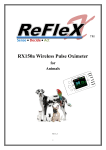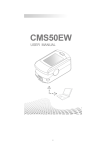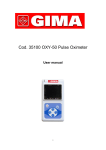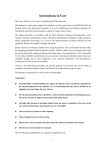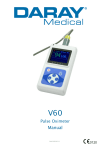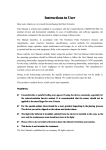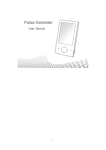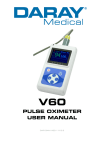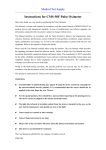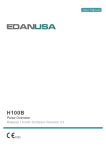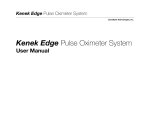Download This Manual is written and compiled in accordance with the council
Transcript
RX101 PPG Recorder Instruction Manual Version 1.3 I Version Control Date Description Version No. May 12, 2012 Initialize first draft - Set table of content 1.0 May 20, 2012 Complete User Instruction 1.1 May 21, 2012 Complete Safety and Introduction 1.2 June 28, 2012 Complete Frist Draft 1.3 II Remark User Instructions This Manual is written and compiled in accordance with the council directive MDD93/42/EEC for medical devices and harmonized standards. In case of modifications and software upgrades, the information contained in this document is subject to change without notice. The Manual describes, in accordance with RX101 PPG Recorder’s features and requirements, main structure, functions, specifications, correct methods for transportation, installation, usage, operation, repair, maintenance, storage, etc. as well as the safety procedures to protect both the user and equipment. Refer to the respective chapters for details. Please read the User Manual carefully before using this product. The User Manual which describes the operating procedures should be followed strictly. Failure to follow the User Manual may cause measuring abnormality, equipment damage and human injury. The manufacturer is NOT responsible for the safety, reliability and performance issues and any monitoring abnormality, personal injury and equipment damage due to users' negligence of the operation instructions. The manufacturer’s warranty service does not cover such faults. Owing to the forthcoming renovation, the specific products you received may not be totally in accordance with the description of this User Manual. We would sincerely regret for that. This product is designed for medical research, education, and health and wellness applications. WARNING: It is recommended that the sensor should not be applied to the same finger for over 2 hours, as the device may disrupt microcirculation on the body part. Be advised that the device cannot be clipped on the edema and tender tissue. Do not stare directly at the LED lights as the light (the infrared is invisible) emitted from the device is harmful to the eyes. Please refer to the correlative literature about the clinical restrictions and caution. Testee cannot use enamel or other makeup. Testee’s fingernail cannot be too long. This device is not intended for treatment. The User Manual is published by ReFleX Wireless Inc. All rights reserved. III Contents 1. SAFETY ..............................................................................................................................................6 1.1 OPERATION PROCEDURES.................................................................................................6 1.2 WARNING .........................................................................................................................6 1.3 CAUTIONS ........................................................................................................................7 2. INTRODUCTION ..............................................................................................................................8 2.1 INTENDED USE .................................................................................................................8 2.2 KEY FEATURES .................................................................................................................8 2.2 APPLICATION AND SCOPE .................................................................................................8 2.3 ENVIRONMENT REQUIREMENTS .......................................................................................8 3. SYMBOLS, CONTROLS, DISPLAY, AND INDICATOR .............................................................9 3.1 FRONT PANEL ...................................................................................................................9 3.2 REAR PANEL...................................................................................................................10 4. SETUP OF RX101 ............................................................................................................................ 11 4.1 LIST OF COMPONENTS .................................................................................................... 11 4.2 INACCURATE MONITOR MEASUREMENTS ....................................................................... 11 5. BATTERY OPERATION ................................................................................................................12 5.1 BATTERY POWER ............................................................................................................12 5.2 BATTERY INDICATOR ......................................................................................................12 5.3 BATTERY CHARGING ......................................................................................................12 6. RX101 OPERATION .......................................................................................................................13 6.1 TURN ON RX101 ............................................................................................................13 6.2 MENU ACCESS................................................................................................................14 6.3 ADJUST LED DISPLAY BRIGHTNESS ...............................................................................14 6.4 SET ALARM LIMIT ..........................................................................................................15 6.5 ENABLE/DISABLE PULSE SOUND....................................................................................15 6.6 CHANGE USER ID .........................................................................................................16 6.7 ENABLE DATA RECORDING (UNDER REVISION) .............................................................16 6.8 ENABLE BLUETOOTH COMMUNICATION .........................................................................16 6.9 CHANGE SCREEN ORIENTATION .....................................................................................16 6.10 EXIT MENU ....................................................................................................................17 6.11 SOFTWARE OPERATION...................................................................................................17 6.12 CAUTIONS ......................................................................................................................17 6.13 CLINICAL RESTRICTIONS ................................................................................................18 7. PERFORMANCE CONSIDERATION ..........................................................................................19 7.1 DYSFUNCTIONAL HEMOGLOBINS ...................................................................................19 7.2 ANEMIA .........................................................................................................................19 7.3 SATURATION (SPO2) .......................................................................................................19 7.4 PULSE RATE (PR) ...........................................................................................................19 7.5 OTHER INACCURACY CAUSES ........................................................................................19 7.6 OTHER PULSE SIGNAL LOSS CAUSES .............................................................................19 7.7 TO USE RX101 PPG RECORDER .....................................................................................20 7.8 HIGH AMBIENT LIGHT SOURCES THAT CAN INTERFERE WITH THE PERFORMANCE OF RX101 IV PPG RECORDER ARE: ..........................................................................................................................20 8. TROUBLESHOOTING...................................................................................................................21 8.1 CORRECTIVE ACTIONS ...................................................................................................21 8.2 EMI (ELECTROMAGNETIC INTERFERENCE) ....................................................................21 8.3 TECHNICAL ASSISTANCE ................................................................................................22 9. MAINTENANCE .............................................................................................................................23 9.1 RETURN RX101 .............................................................................................................23 9.2 TO RETURN THE RX101 .................................................................................................23 9.3 SERVICE .........................................................................................................................23 9.4 PERIODIC SAFETY CHECKS .............................................................................................23 9.5 CLEANING ......................................................................................................................23 10. MENU STRUCTURE .................................................................................................25 12. SPECIFICATIONS .....................................................................................................27 13. KEY SYMBOLS ..........................................................................................................28 14. DEVICE FUNCTIONS ...............................................................................................29 APPENDIX ...........................................................................................................................................30 V 1. Safety 1.1 Operation Procedures Check the main unit and all accessories periodically to look for visible damages that may affect patient’s safety and monitoring performance. It is recommended that the device be inspected once a week, and when a damage is observed, stop using the device. Technical maintenance must be performed by qualified service engineers ONLY. The device cannot be used together with devices not specified in the User Manual. Only the accessories appointed or recommended by the manufacturer can be used with this device. The product is pre-calibrated at the factory. 1.2 Warning Warnings are identified by the WARNING symbol shown above. Warnings alert the user to potential serious outcomes, such as death, injury, or adverse events to the user. Explosive hazard—DO NOT use the PPG Recorder in environment with inflammable gas such as some ignitable anesthetic agents. DO NOT use the PPG Recorder while the testee is measured by MRI and CT. DO NOT strand the lanyard in order to avoid device drop and damage. The lanyard is made of non-sensitive material. Please do not use lanyard if the user is allergic to lanyard. Do not enwind neck with lanyard in order to avoid accident. Follow the local laws and regulations when disposing a defective instrument, its accessories and packaging (including battery, plastic bags, foams and paper boxes). Please ensure that all items are present in the package prior using the device. Only use accessories and probe approved or manufactured by the manufacturer to prevent damages to the PPG Recorder. Please choose the battery chargers that are compliant with the requirements of IEC 60601-1 People who are allergic to rubber cannot use this device. RX101 is not defibrillator-proof. However, it may remain attached to the testee’s finger throughout defibrillation or while an electrosurgical unit is in use. The measurements may be inaccurate throughout the defibrillation, or use of an electrosurgical unit, and shortly thereafter. To avoid shock, caregiver should not hold RX101 while using a defibrillator on a person. To ensure accurate performance and prevent device failure, do not subject RX101 to extreme moisture, such as direct exposure to rain. Such exposure may cause inaccurate performance or device failure. Please do not use the device during charging. This device can only be matched with compatible probe. 6 RX101 PPG Recorder Instruction Manual 1.3 Cautions Cautions are identified by the CAUTION symbol shown above. Cautions alert the user to exercise care necessary for the safety and effective use of RX101 handheld PPG Recorder. All combinations of equipment must be in compliance with IEC Standard 60601-1-1 systems requirements. Keep the PPG Recorder away from dust, vibration, corrosive substances, explosive materials, high temperature and moisture. If the PPG Recorder gets wet, please stop operating it. If the device was previously stored in cold environment, please wait for the device to accustom to the environment before using. DO NOT operate the button on front panel with sharp materials. High temperature or high pressure steam disinfection of the PPG Recorder is not permitted. Refer to User Manual in the relative chapter (10.5) for instru ctions of cleaning and disinfection. Do not have the PPG Recorder immerged in liquid. When it needs cleaning, please wipe its surface with medical alcohol by soft material. Do not spray any liquid on the device directly. When cleaning the device with water, the temperature should be lower than 60oC. If the testee’s finger is too thin or cold. The readings may not be accurate. Please clip the PPG Recorder on the thicker finger such as thumb or middle finger with sufficient depth to obtain better reading. The PPG Recorder is designed for adult measurements only. Proper measurement should take less than 5 seconds; how this may change depending on each individual’s pulse rate. Please take the measurement when the waveform on screen becomes stabilized to ensure the accuracy of the readings. If some abnormal conditions appear on the screen during test process, remove the PPG Recorder from the finger and then re-clip the recorder on the finger to reset the reading on the display. The device has normal useful life of three years counting from its first day of use. This device has an alarm function. Please refer to chapter 6.4 for reference. The device has audible alert which is sounded when the highest or lowest limit are reached. The device has the function of alarming, this function can either be paused, or closed (default setting). To access the device MENU please refer to chapter 6.1 for reference. The device may not obtain accurate readings on all users. When the device is connected with USB cable, always pick up the device itself and do not hold it by the USB cable. Stopping using the device if the device is unable to obtain stable readings. 7 RX101 PPG Recorder Instruction Manual 2. Introduction WARNING: Do not make any clinical judgments based on RX101. The monitor is intended only for health and wellness applications. 2.1 Intended Use The pulse oxygen saturation is the percentage of HbO2 in the total Hb in the blood, also known as the O2 concentration in the blood. It is an important bio-parameter for the respiration. In addition to O2 Saturation, the device can also measure heart rate and record the heart waveform (AKA photoplethysmogram). The device brings excellent value for scientific research, education, and health and wellness applications. To operate the PPG Recorder, simply clip the recorder on a finger and the photoplethysmogram, heart rate and oxygen saturation will display on the LED screen of the device. 2.2 Key Features A. Easy to operate using the Home Button located next to the LED screen. B. Rechargeable battery C. Low power consumption D. Support wireless data transmission of heart rate, Oxygen Saturation and heart waveform (photoplethysmogram) 2.2 Application and Scope The PPG Recorder measures oxygen saturation and pulse rate through a person’s fingers and toes (in some cases). It is designed to be used in scientific research, education, health and wellness applications. Warning: The problem of over-estimation may occur when the person is suffering from toxicosis which is caused by carbon monoxide. Thus, the device is not recommended to be used under this circumstance. 2.3 Environment Requirements Storage Environment a) Temperature :-40oC~+60 oC b) Relative humidity :5%~95% c) Atmospheric pressure :500hPa~1060hPa Operating Environment a) Temperature:10 oC ~40 oC b) Relative Humidity :30%~75% c) Atmospheric pressure:700hPa~1060hPa 8 RX101 PPG Recorder Instruction Manual 3. Symbols, Controls, Display, and Indicator 3.1 Front Panel This section identifies the symbols, controls, displays, and indicators on RX101. Figure 1: RX101 Front Panel Table 1: RX101 Front Panel Description Index Name SpO2 Lower Limit 1 Home Button 2 3 4 5 6 7 8 9 10 11 SpO2 Alarm Indicator Pulse Beat Sound Battery Indicator Charging Indicator Wireless Indicator Pulse Rate Pulse Amplitude Waveform Screen Description Lower Limit Alarm Threshhold (set in the Alarm Menu) Use this button for Powering Up, change Screen Orientation, Scroll Down and other features Oxygen Saturation Reading To indicate if the alarm is on, off or temporarily muted To indicate if the pulse beat sound is on/off To show the current battery status The Blue LED indicates the device is charging To indicate if Bluetooth is on. To indicate the number of pulse per minute To indicate the normalized pulse strength To show the photoplethysmogram (Heart Waveform) 9 RX101 PPG Recorder Instruction Manual 3.2 Rear Panel Figure 2: RX101 Back Panel Table 2: RX101 Back Panel Description Index Name USB Port 1 Through Hole 2 Device Label 3 4 Speaker Hole Description For battery charging or attaching external sensor probe For lanyard installation The label contains the technical specifications, manufacturing details and certification information. The is where the alarm speaker is mounted. 10 RX101 PPG Recorder Instruction Manual 4. Setup of RX101 WARNING: To ensure patient safety, do not place RX101 in any position that might cause it to fall on the patient. WARNING: As with all medical equipment, carefully route patient’s cables to reduce the possibility of patient entanglement or strangulation. WARNING: Ensure that the speaker is clear of any obstruction and that the speaker holes are not covered. Failure to do so could result in an inaudible alarm tone. WARNING: To ensure accurate performance and prevent device failure, do not subject RX101 to extreme moisture, such as direct exposure to rain. Such exposure may cause inaccurate performance or device failure. 4.1 List of Components Table 3: List of Components Quantity Name RX101 PPG Recorder 1 USB Cable 1 Lanyard 1 Instruction Manual 1 1 Quick Start Guide Description A finger PPG Recorder For charging RX101 To wear the PPG Recorder as a pendant The instruction manual is included in the mini-CD or is downloadable on www.reflexwireless.com This is a simplified version of the instruction manual 4.2 Inaccurate Monitor Measurements Physiological conditions, medical procedures, or external agents that may interfere with the PPG Recorder’s ability to detect and display accurate measurements include: incorrect application of RX101 PPG Recorder placement of RX101 record clip on an extremity with a blood pressure cuff, arterial catheter, or intravascular line excessive patient activity intravascular dyes, such as indocyanine green or methylene blue externally applied coloring agents, such as nail polish, dye, or pigmented cream 11 RX101 PPG Recorder Instruction Manual 5. Battery Operation WARNING: Dispose of battery in accordance with local ordinances and regulations. 5.1 Battery Power RX101 uses rechargeable Lithium Polymer battery to power the PPG Recorder. Depending on usage, the battery can last from 5 hours to 40 hours per charge cycle. The battery will drain faster if the Bluetooth connectivity is switched on. 5.2 Battery Indicator Below are the five battery statuses: Power supply by battery only, and battery status is full Battery status is not full Battery status is at the verge of self-shutdown Low power alarm indicator Charging Indicator (behind lanyard through hole) WARNING: If the alarm function is on, the device will provide high-priority alarm signal when the battery is in low power status. Intermittent alarm will occur and the battery icon turns red in the state of flashing. High priority indicats that immediate response by the operator is required. 5.3 Battery Charging There are two battery charging methods: a) Connect the device to a computer using the USB Cable. b) Connect the device to the enclosed DC power adaptor using the USB Cable 12 RX101 PPG Recorder Instruction Manual 6. RX101 Operation The parameters of RX101 are set at the factory according to Table 2. The parameters can be customized for each individual user. Parameters remain in effect until changed by the user. Table 5: Default Parameter Settings Parameter %SpO2 Upper Alarm Limit %SpO2 Lower Alarm Limit Pulse Rate Upper Alarm Limit Pulse Rate Lower Alarm Limit Alarm Pulse Beep LED Display Brightness Data Recording Wireless ID Value Range 85~100 0~99 50~254 0~150 On/Off On/Off 1~4 On/Off On/Off Any four alpha numeric characters Default 99 85 150 50 Off Off 3 Off Off User (can only be set using RX101 software) 6.1 Turn on RX101 6.1.2 Discussion The software version appears in the monitor display each time when it successfully completes the power-on self-test. Write the number down so it is available when you request technical assistance. Caution: During the Power-On-Self-Test immediately after power-up, confirm that the LED display and icons are shown and the monitor speaker sounds a one-second tone. WARNING: If do not hear the pass tone, do not use RX101 6.1.2 Procedure 1. Press the Home Button for two seconds 2. See the opening screen with the software version number located on the lower right hand corner 3. Wait for 60 seconds for the data to become stabilized if the device has not been used for over two hours. Auto-shut off 4. The device will shut-off automatically after 3 seconds of inactivity. 13 RX101 PPG Recorder Instruction Manual Figure 3: Clip the PPG Recorder on the Forefinger To obtain good reading, always try clipping the sensor on the forefinger first. If unable to obtain readings, try clipping the sensor on the thumb to increase contact area between the sensor and the body part. 6.2 Menu Access Press the “Home Button” as shown in figure 1 (page 4) for 2 seconds to access the Settings menu. This area allows users to modify various device settings, such as alarm, pulse indicator, backlight, data storage, and user ID ….The procedure is as follows: Figure 4: Settings Menu 6.3 Adjust LED Display Brightness Press the “Home Button” for 2 seconds to enter the Settings Menu. Brightness is lighted with a blue rectangular bar indicating the menu item is currently selected. Push the “Home Button” again for two seconds to adjust the brightness to the next level. The brightness level will rotate from 1 to 4 for each two seconds the Home Button is pushed. If only push the “Home Button” for 1 quick second, the menu selection bar (the blue rectangular bar) will move to the next menu item. If this occurs, please give a few consecutive quick pushes on the “Home Button” to return the menu selector back to “Brightness” To exit the Settings Menu, simply give the “Home Button” a few quick pushes until the menu selector highlights “Exit”, and then push the “Home Button” for two seconds to exit the menu. Figure 5: Exit Settings Menu 14 RX101 PPG Recorder Instruction Manual 6.4 Set Alarm Limit Press the “Home Button” for 2 seconds to enter the Settings Menu. Brightness is lighted with a blue rectangular bar indicating the menu item is currently selected. Push the “Home Button” again for a quick second to enter the Alarm Menu. Figure 6: Alarm Menu Access Figure 7: Alarm Settings Menu By default, “Dir” is highlighted with its setting “down”. This sets the adjust direction in the “decreasing mode” and allows user to adjust the Alarm Settings downward (ie from 099 to 098). To change to increasing mode, push the “Home Button” for 2 seconds while the menu selector is on “Dir”. a. The Highest/Lowest Alarm Limit Setting Assuming the “Dir” setting is “down,” give the “Home Button” a few quick pushes to move the menu selector to one of the menu items. Once the desired Alarm setting is highlighted, push the “Home Button” for two seconds to decrease the alarm setting by 1 or push and hold the Home Button to keep decreasing the Alarm setting until the desired number is reached. To increase the Alarm setting, give the “Home Button” a few quick pushes until the menu selector highlights “Dir” and then pushes the “Home Button” for two seconds to set the adjust direction to “Up”. Give the “Home Button” a few quick pushes to move the menu selector to the desired Alarm setting, and then push and hold the “Home Button” to increase the Alarm setting. Warning: If the alarm function is on, the device will provide medium-priority alarm signal when the data of SpO2 or pulse rate is beyond the limit. Intermittent alarm will occur and the measurement shows in yellow. Warning: Medium priority indicating that prompt operator response is required. b. Enable/Disable Alarm Give the “Home Button” a few quick pushes until the menu selector highlights “Alarm” and then push the “Home Button” for two seconds to change the setting to “on” to turn on the Alarm Alert. 6.5 Enable/Disable Pulse Sound Give the “Home Button” a few quick pushes until the menu selector highlights “Pulse Sound” and then push the “Home Button” for two seconds to change the setting to “on” to turn on the Pulse 15 RX101 PPG Recorder Instruction Manual Sound. 6.6 Change USER ID The user can modify device ID by "AQWave". AQwave Software is currently available in Android and PC. MAC and iOS version will be released in December 2012. Figure 8: Set User ID 6.7 Enable Data Recording (Under Revision) Figure 9: Record Data 6.8 Enable Bluetooth Communication Turn on the Wireless Feature on the PPG Recorder by moving the menu selector to highlight “Wireless” and then push the “Home Button” for 2 seconds to enable “Wireless” communication. To connect to the PPG Recorder using your Android, iOS device or desktop computer, please follow the instructions provided the mobile or PC application and use the passcode “7762” to have the data from the PPG Recorder stream to the software applications. Figure 10: Enable Wireless Communication 6.9 Change Screen Orientation On the measuring interface, press the "Home Button" to change the display orientation. 16 RX101 PPG Recorder Instruction Manual 6.10 Exit Menu To exit the Settings Menu, simply give the “Home Button” a few quick pushes until the menu selector highlights “Exit”, and then push the “Home Button” for two seconds to exit the menu. Figure 11: Exit the Settings Menu 6.11 Software Operation Please connect the device with computer by a USB Cable or Bluetooth connection, and then follow the instruction specified in the software applications. For Android applications, they can be downloaded via Google Play (search keyword: AQWave). As for the PC software please download it on www.aqwave.com. 6.12 Cautions Please check if the device is functioning properly prior each use. Attach the sensor probe at the appropriate locations, such as the one illustrated in figure 3 to ensure device reading accuracy. The SpO2 sensor and photoelectric receiving tube should be arranged in a sequence such that the subject’s arteriole is in between the light emitter and the light sensor. The SpO2 sensor should not be used at a location or limb tied with arterial canal or blood pressure cuff or at a site where intravenous injection is applied. Do not fix the SpO2 sensor with adhesive as it may be affected by venous pulsation and produces inaccurate measure of SpO2 and pulse rate. Excessive ambient light may affect the measuring result. This includes fluorescent lamp, dual ruby light, infrared heater, direct sunlight and etc. Strenuous action of the subject or extreme electrosurgical interference may also affect the accuracy of the sensor reading. Please clean and disinfect the device after each use according to the User Manual. 17 RX101 PPG Recorder Instruction Manual 6.13 Clinical Restrictions a) Since the measurement is taken on the basis of arteriole pulse, substantial pulsating blood flow of subject is required. A subject with weak pulse due to shock, low ambient/body temperature, major bleeding, or use of vascular contracting drug, the SpO2 waveform (PLETH) will decrease. In this case, the measurement will be more sensitive to interference. b) For those with a substantial amount of staining dilution drug (such as methylene blue, indigo green and acid indigo blue), or carbon monoxide hemoglobin (COHb), or methionine (Me+Hb) or thiosalicylic hemoglobin, and some with icterus problem, the SpO2 determination by this monitor may be inaccurate. c) The drugs like dopamine, procaine, prilocaine, lidocaine and butacaine may also be a major factor resulted in serious error of SpO2 measure. d) As the SpO2 value serves as a reference value for judgment of anemic anoxia and toxic anoxia, some people with serious anemia may also report good SpO2 measurement. 18 RX101 PPG Recorder Instruction Manual 7. Performance Consideration WARNING: PPG Recorder readings and pulse signals can be affected by ambient environmental conditions, OXIMAX sensor application errors, and patient conditions. This section describes patient conditions that can affect the PPG Recorder’s measurements. 7.1 Dysfunctional Hemoglobins Dysfunctional hemoglobins, such as, carboxyhemoglobin, methemoglobin, and sulfhemoglobin, are unable to carry oxygen. SpO2 readings may appear normal; however, a person may be hypoxic because less hemoglobin is available to carry oxygen. Further assessment beyond PPG Recorder is recommended. 7.2 Anemia Anemia causes decreased arterial oxygen content. Although SpO2 readings may appear normal, an anemic person may be hypoxic. Correcting anemia can improve arterial oxygen content. The PPG Recorder may fail to provide a SpO2 reading if hemoglobin levels fall below 5 gm/dl. 7.3 Saturation (SpO2) The monitor displays saturation levels between 1% and 99%. 7.4 Pulse Rate (PR) The monitor displays pulse rates between 30 and 250 beats per minute. The sensor accuracy ranges do not apply to pulse rates above 230 bpm. Detected pulse rates below 30 are shown as 0. 7.5 Other Inaccuracy Causes • incorrect application of the PPG Recorder • placement of the PPG Recorder on an extremity with a blood pressure cuff, arterial catheter, or intravascular line • excessive patient activity • intravascular dyes, such as indocyanine green or methylene blue • externally applied coloring, such as nail polish or pigmented cream • venous pulsation • dysfunctional hemoglobin • low perfusion 7.6 Other Pulse Signal Loss Causes • testee’s finger not inserted into the PPG Recorder sufficiently • defibrillation • a blood pressure cuff is inflated on the same extremity as the one with the PPG Recorder attached • there is arterial occlusion proximal to the PPG Recorder • poor peripheral perfusion • loss of pulse/cardiac arrest 19 RX101 PPG Recorder Instruction Manual 7.7 To use RX101 PPG Recorder • Apply the sensor as directed, and observe all warnings and cautions presented in the Directions • Clean and remove any substances, such as nail polish, from the application site. • Periodically check to ensure that the PPG Recorder remains properly positioned on the testee’s finger. 7.8 High ambient light sources that can interfere with the performance of RX101 PPG Recorder are: • surgical lights (especially those with a xenon light source) • bilirubin lamps • fluorescent lights • infrared heating lamps • direct sunlight 7.9 To prevent interference from ambient light, ensure that the PPG Recorder is properly applied. If interference due to testee’s activity presents a problem, try one or more of the following to correct the problem: • verify that RX101 PPG Recorder is properly and securely applied • move the PPG Recorder to another site • keep the testee still, if possible 20 RX101 PPG Recorder Instruction Manual 8. Troubleshooting Warning: If you are uncertain about the accuracy of any measurement, check the patient's vital signs by alternate means; then make sure RX101 is functioning correctly. Warning: There are no user-serviceable parts inside RX101. The cover should only be removed by qualified service personnel. Caution: Do not spray, pour, or spill any liquid on RX101, its accessories, connectors, switches, or openings in the enclosure as this may damage the device. 8.1 Corrective Actions Issues The SpO2 and Pulse Rate are not shown or not stabilized after 10 seconds Corrective Action(s) • Perfusion may be too low for the PPG Recorder to track the pulse. Check the patient. Use the monitor on yourself. Change the measurement site. Try another sensor. • Interference due to patient activity may be preventing the PPG Recorder from tracking the pulse. Keep the patient still, if possible. Verify that the PPG Recorder is securely applied and replace it, if necessary. Change the measurement site. • The sensor may be too tight, there may be interference due to ambient light, or the sensor may be on an extremity with a blood pressure cuff, arterial catheter, or intravascular line. Reposition sensor, as necessary. • Electromagnetic interference may be preventing the monitor from tracking the pulse. Remove the source of interference. There is no response to the Home Button. • Ensure that the Home Button is fully depressed. • The batteries may be fully discharged. The LED display suddenly turns off. Please recharge the battery. The device operation time appears to be shortened 1. Please recharge the battery 2. Please contact the local service center. 8.2 EMI (Electromagnetic Interference) Caution: This device has been tested and found to comply with the limits for medical devices to the EN60601-1-2, (second edition), and the Medical Device Directive 93/42/EEC. These limits are designed to provide reasonable protection against harmful interference in a typical medical installation. Due to the proliferation of radio-frequency transmitting equipment and other sources of electrical noise in healthcare environments, it is possible that high levels of such interference due to close proximity, or strength of a source, may result in disruption of performance of this device. Examples of noise sources in healthcare environments that could cause electromagnetic interference are: • electrosurgical units 21 RX101 PPG Recorder Instruction Manual • cellular phones • mobile two-way radios • electrical appliances • high-definition television The monitor is not designed for use in environments in which the pulse can be obscured by electromagnetic interference. During such interference, measurements may seem inappropriate or the monitor may not seem to operate correctly. Disruption may be evidenced by erratic readings, cessation of operation, or other incorrect functioning. If this occurs, the site of use should be surveyed to determine the source of this disruption, and the following actions need to be taken to eliminate the source: • Turn equipment in the vicinity off and on to isolate the offending equipment. • Reorient or relocate the interfering equipment. • Increase the separation between the interfering equipment and this equipment. The monitor generates, uses, and can radiate radio frequency energy. If it is not installed and used in accordance with these instructions, RX101 may cause harmful interference with other devices in the vicinity. 8.3 Technical Assistance For technical information and assistance, or to order parts or a service manual, contact ReFleX Wireless’s Technical Service Department at: [email protected] Or call your local ReFleX Wireless representative. The service manual includes block diagrams and a parts list required by qualified personnel when servicing RX101. Be sure to provide the software version number of the monitor when you request technical assistance. The software version appears in the monitor display each time when it successfully completes the power-on self-test. Write the number down so it is available when you request technical assistance. 22 RX101 PPG Recorder Instruction Manual 9. Maintenance Warning: There are no user-serviceable parts inside RX101. The cover should only be removed by qualified service personnel. Caution: The institution should follow local government regulations and recycling instructions regarding disposal or recycling of the batteries and RX101 components or end of life of RX101. Caution: RX101 will not operate with dead batteries. Please check the battery prior each use. 9.1 Return RX101 Contact ReFleX Wireless’s Technical Service Department at: [email protected] for shipping instructions including a Returned Merchandise Authorization (RMA) number. Unless otherwise instructed by ReFleX Wireless’s Technical Service Department, it is not necessary to return the sensor probe or other accessory items with RX101. 9.2 To return the RX101 1. Pack RX101 in its original shipping carton. If the original carton is not available, use a suitable carton with appropriate packing material to protect it during shipping. 2. Return RX101 by any shipping method that provides proof of delivery. 9.3 Service Warning: There are no user-serviceable parts inside RX101. The cover should only be removed by qualified service personnel. The monitor requires no calibration. If service is necessary, contact qualified service personnel or your local ReFleX Wireless Representative. 9.4 Periodic Safety Checks It is recommended that the following checks be performed every 24 months: • inspect the equipment for mechanical and functional damage • inspect the safety relevant labels for legibility 9.5 Cleaning Caution: Do not spray, pour, or spill any liquid on RX101 or its accessories, connectors, switches, or openings in the enclosure as this may damage the monitor. You can surface-clean and disinfect RX101 PPG Recorder and the sensor probe. 23 RX101 PPG Recorder Instruction Manual To surface-clean the monitor: use a soft cloth dampened with either a commercial, nonabrasive cleaner, or a solution of 70% alcohol in water lightly wipe the surfaces of the monitor To disinfect the monitor: • use a soft cloth saturated with a solution of 10% chlorine bleach in tap water To clean and disinfect a reusable sensor probe: • read the directions for use enclosed with the sensor probe Each sensor probe model has cleaning and disinfecting instructions specific to that sensor. 24 RX101 PPG Recorder Instruction Manual 10. Menu Structure RX101 PPG Recorder Menu Structure Figure 12: Settings Menu Structure 25 RX101 PPG Recorder Instruction Manual 11. Principle of Operation This PPG Recorder is powered by lithium polymer battery. In addition to viewing the data on the built-in OLED display, data can also be transmitted via Bluetooth to other portable electronic devices, such as computers, tablets or smart phones. The device algorithm is based on the absorption difference of red and infrared light by oxy-hemoglobin (HbO2) and deoxy-hemoglobin (Hb) and the Lambert Beer Law. The device design is based on photo oximetry and volumetric pulsatile flow monitoring technique. By transmitting two different wavelength of light through a fingertip, pulsatile flow signals are collected using a photo detector. The signal is then processed via the on-board microcontroller and the result is displayed on the built-in OLED screen. Figure 13: Principle of Operation of the PPG Recorder The data is collected at the sampling frequency of 120Hz. Upon processed by the main board, the processed data is then displayed. To transmit the data wirelessly via Bluetooth, the wireless feature in the device menu needs to be enabled using the “Home Button” next to the device display. Alarm feature can also be activated via the same menu. 26 RX101 PPG Recorder Instruction Manual 12. Specifications A. Measurement of SpO2 Measuring range: 0%~100% Accuracy: When the SpO2 measuring range is 70%~100%, the permission of absolute error is ±2%; below 70% is unspecified B. Measurement of Pulse Rate Measuring range: 30bpm~250bpm Accuracy: ±2 bpm or ±2% (select larger) C. Resolution SpO2 : 1%, Pulse rate: 1bpm. D. Measurement Performance in Weak Filling Condition: SpO2 and pulse rate can be shown correctly when pulse-filling ratio is 0.4%. SpO2 error is ±4%, pulse rate error is ±2 bpm or ±2% (select larger). E. Resistance to surrounding light The deviation between the value measured in the condition of man-made light or indoor natural light and that of darkroom is less than ±1%. F. Power supply requirement 3.6 V DC ~ 4.2V DC. G. Optical Sensor Red light (wavelength is 660nm, 6.65mW) Infrared (wavelength is 880nm, 6.75mW) H. Adjustable alarm range: SpO2 : 0%~100% Pulse Rate: 0bpm~254bpm 27 RX101 PPG Recorder Instruction Manual 13. Key Symbols Symbols Description Warning – See User Manual Percentage of Oxygen Concentration PR Pulse rate bpm Beat per Minute Alarm sound disabled Pause the alarm sound indicator Alarm sound enabled Disable the pulse sound indication Open the pulse sound indication Power on/off Menu Change Screen Orientation BF Type application part SN Serial number 1. The measured part falls off ( no measured part inserted) 2. Probe error 3. Signal inadequacy indicator IPX1 Ingress of liquids rank WEEE (2002/96/EC) 28 RX101 PPG Recorder Instruction Manual 14. Device Functions Information Display Mode The Oxygen Saturation (SpO2) 2-digit digital TFT display Pulse Rate (PR) 3-digit digital TFT display Pulse Intensity (bar-graph) bar-graph TFT display SpO2 Parameter Specification Measuring range 0%~99%, (the resolution is 1%) Accuracy 70%~100%: ±2% , Below 70% is unspecified Average value Calculate the Average value of every 4 measure value. The deviation between average value and true value does not exceed 1% Pulse Parameter Specification Measuring range 30bpm~250bpm, (the resolution is 1bpm) Accuracy ±2bpm or ±2% (whichever is greater) Average pulse rate Average pulse rate is computed based on every four cardio-beat per cycle. The deviation between average value and true value does not exceed 1% Safety Type Interior Battery, BF Type application part Pulse Intensity Range Continuous bar-graph display indicates the pulse strength. Battery Requirement 3.7 V rechargeable lithium polymer battery × 1 Battery working life Charge and discharge no less than 500 times Power Adapter Input Voltage 100 ~ 240 VAC, 50/60 Hz Output Voltage 5 V (DC) 29 RX101 PPG Recorder Instruction Manual Output current 250mA Output power 1.25 W Oximeter Probe Wavelength:660nm, 880nm Dimensions and Weight Dimensionsi 87(L) × 45(W) × 22(H) mm Weight About 175 g (with the lithium polymer battery*1) Appendix State Alarm condition delay Alarm signal generation delay Low voltage alarm 1s 20ms SpO2 alarm 330ms 20ms Pulse rate alarm 330ms 20ms Probe error alarm 16ms 20ms 30 RX101 PPG Recorder Instruction Manual






























